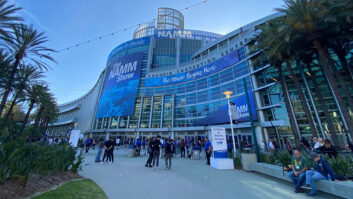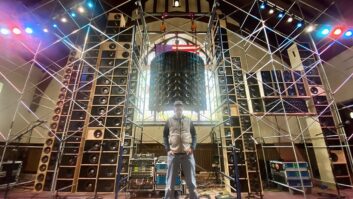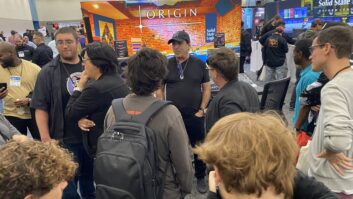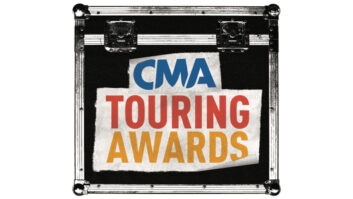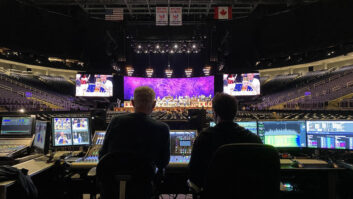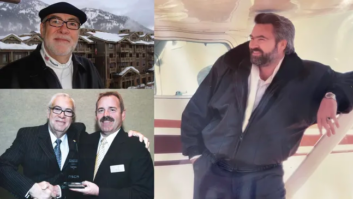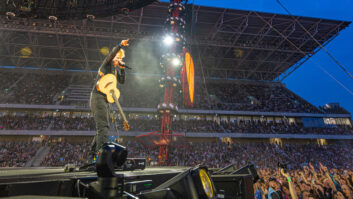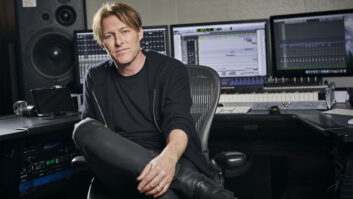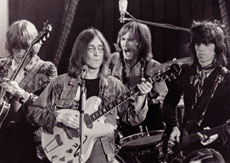
A moment from The Rolling Stones Rock and Roll Circus.
A quick perusal of the music DVDs section at your local music store will tell you that this is a booming area bringing in a lot of work to recording engineers and mixers, as well as those folks on the visual end. The pre-Christmas period has become particularly fertile, so Mix decided to take a look at some of the audio considerations that went into the making of four fall music DVD releases. Trends? Pro Tools is as ubiquitous in this sonic universe as it is in all others. Also, it appears that the center channel is moving toward obsolescence and even the sub is losing favor on music-oriented projects. What does that leave us with? Glorified quad! Oh well, could be worse!
REVISITING THE STONES’ CIRCUS

Filmed for the BBC in December 1968, but unseen until released on videocassette and Laserdisc in the mid-’90s, The Rolling Stones Rock and Roll Circus is one of the more fascinating musical documents of the late ’60s. It provides an intimate glimpse of some of Britain’s true rock royalty — the Stones, The Who, Jethro Tull and a “supergroup” called The Dirty Mac, which comprised John Lennon, Eric Clapton, Keith Richards (on bass!) and Jimi Hendrix Experience drummer Mitch Mitchell. Also featured on the mock circus set at Intertel Studios in Wembley were Marianne Faithfull, Taj Mahal, various circus acts and — oh yes! — Yoko Ono cavorting in a black sack and screeching a bit. Stones producer Jimmy Miller, who’d just finished Beggar’s Banquet with the group, was the musical producer; Glyn Johns engineered in Olympic Studios’ mobile truck, while Michael Lindsay-Hogg directed.

The production ended up being quite grueling, and in the end, Mick Jagger was not satisfied with the Stones’ performance, so the special was not aired. Its release in the ’90s involved a great deal of audio and video excavation work — a story in itself. Now, the DVD has even better sound and the requisite bonus features, including more songs from Taj Mahal, a fascinating interview with Pete Townshend, more backstage footage and audio commentaries from various Stones, the director and others.
One of the serious challenges on the audio end, both in 1996 and today, was turning the 3-track master tape “with no separation whatsoever,” according to co-producer Mick Gochanour, into an effective surround program. The initial work was done by Steve Rosenthal at The Magic Shop in New York City; he spearheaded the ABCKO remastering of the original Stones albums for SACD a few years ago, as well. According to Gochanour, the surround mix that was used for the film’s theatrical showings in 1996 was transferred to Dolby AC-3 for the Laserdisc. More recently, the cleaned-up and separated tracks were turned over to Jonathan Porath of Sound One in Manhattan for the 5.1 DVD mix.
“There are a few things you can do with a 3-track source to get it to 5.1, particularly with the tools available today,” Gochanour says. “You can extract a lot and separate a lot with filters and there’s a little bass extension going on. We have mostly audience in the rears and a general room feel. We were very careful to keep it in line with what you’re seeing. We took the tack of this being a film mix, not just a music mix, and in this case, there are a lot of close-ups, so you have to be careful. When you’re right in someone’s face, you don’t want too much reverb; it would feel out of place. We also did a 2-track music mix on the DVD and it’s crankin’. It’s a little tighter, particularly on the bottom end.”
Porath had access to The Magic Shop’s original stems, which had been loaded, along with the first stereo mix of the program and the original surround mix, onto a single 48-track DASH tape in the ’90s. “Having everything on one DASH tape made it easy when we went back to do the 5.1 because we had all the different elements at our disposal,” he says. “Because the mastering/authoring was going to be done in Pro Tools, we decided to record to Pro Tools to be more efficient and save generations. Pro Tools also let us get out a few of the clicks and pops that had always bothered me that we weren’t able to eliminate earlier.” Porath did his work in Studio A at Sound One, which was equipped with a Neve VR 60 console, but now has a Neve DFC.
“I used some of the elements [from the original mixes],” Porath says, “but I also did a number of things to the original elements. We were able to make it sound bigger and enhance some things like the bottom end. We were able to build the crowds by stealing little bits from other places. There was also a little bit of Foley work in a few areas — some clapping. At the same time, we always tried to keep it very authentic. That was always a main goal.”
HANGIN’ WITH SOME OF JAZZ’S BEST

The Hang DVD and CD brings together some of the brightest lights of contemporary jazz for a consistently dynamic session that fuses a straight-ahead jazz approach with Latin, African, rock and other styles. The generous and adventurous 14-song set is anchored by leader/arranger/keyboardist Don Grusin and features a revolving cast of greats including Grusin’s older brother (and fellow keyboardist) Dave; bassists Nathan East and Abraham Laboriel; percussionists Alex Acuña, Pete Escovedo and Harvey Mason; singer Patti Austin; guitarists Lee Ritenour, Ricardo Silveira and Frank Quintero; sax players Sadao Watanabe and Ernie Watts; and a host of other players and singers. For a one-off group who play structured but highly improvised music, their chemistry is truly astounding. The original recording — to a 24/96 Nuendo system — was done by Greg Ladanyi at the short-lived L.A. club Platinum Live. Stereo and 5.1 mixes were in Pro Tools by Paul Klingberg at his Red Note Studio in Santa Monica, Calif. Steve Hall of Future Disc handled mastering chores.
“There was a huge amount of music to go through,” Klingberg says. “There was three days of material — I had about a terabyte of data to work through, including rehearsals; it was a lot to manage. When I got it, no editing had been done, so I could take the straight .WAV files — 48 tracks — from Nuendo and move them onto Pro Tools|HD, which is my main tool. Then I built my own Pro Tools session from those.
“At first,” Klingberg continues, “all I could go by was audio. I didn’t have any picture in the beginning stages. I was probably three-quarters of the way through before I got the picture — there had been no line cut done at the shows, and Don [Grusin] didn’t have rough mixes. When I inherited these files, it was a huge undertaking, just piecing these things together. Don had taken a lot of notes, so we sort of had a road map, but that all changed as we worked through it.” Klingberg got his clues about the sound of the room from listening to the music and, later, seeing the video, but he notes that “Don has a well-deserved reputation for making these great-sounding and pristine records, so we wanted to keep it very hi-fi and not have a lot of ambience. We wanted it to be tight and have that clarity and snappiness that an album has.”

Paul Klingberg mixed The Hang entirely in Pro Tools.
Klingberg mixed the entire project within Pro Tools. “It was 100-percent mixing by mouse. Pro Tools has a fabulous interface for 5.1. Its surround capabilities are awesome and it’s so much faster working that way. I just finished mixing a project that was even bigger, a concert by Earth, Wind & Fire and Chicago, and once again it was all done in Pro Tools with tons of Waves plug-ins. I went into POP and they couldn’t believe I did this three-hour show with a Kensington turbo-mouse and a bunch of Waves plug-ins. But that’s the smartest and fastest way of working I know.” Klingberg uses British-made PMC AML-1 monitors for his surround work. “I absolutely love ’em,” he says. “I was one of the first guys in L.A. to get them.”
When it comes to 5.1 mixing, Klingberg says that, increasingly, “I’m really shying away from the center channel, putting less and less in there. By doing that, you’re removing one of the many landmines that can go off in a consumer’s home theater system. Especially with vocals — I never, ever put vocals in there. Us music guys have been shoehorned into using that center channel because it’s there. It has a very specific role in theatrical [films], but it’s not really necessary for music. LFE is the same way, too: There is nothing at all that is bass-dependent in that LFE channel. It’s back to what Alan Parsons said years ago: ‘I’m moving more toward a quad sound.’
“It’s still important for me to get my stereo mix together before I even think about 5.1,” he continues. “I’ve had 25 years of working in stereo, so I have developed my approach to mixing that way. I’ll always start in stereo and then build out from there.”
On The Hang project, Klingberg found himself going back and forth between the demands of the DVD and the CD. “I changed all my buses to a stereo out and went through everything and did some tweaks appropriate to stereo.” Then, using a Martinsound MultiMAX multiformat monitor controller, he was able to easily switch back and forth between stereo and surround mixes as he worked.
BOZ IS BACK…IN STEREO AND 5.1

Between his fine jazz standards album last year, But Beautiful, and this fall’s Greatest Hits DVD/CD, Boz Scaggs has re-emerged as a vital force in music after laying low for a number of years. Greatest Hits has Scaggs and his crack rock/R&B/blues band performing at the venerable Great American Music Hall in San Francisco, rolling through 16 songs covering every phase of his solo career, from the bluesy jam classic “Loan Me a Dime” through all of his mid-’70s smashes (“Lido,” “Slow Dancer,” et al) and more recent triumphs. Scaggs looks and sounds great; the DVD is a highly satisfying tour through his singular oeuvre.
The music was recorded to Pro Tools by engineer J. Michael Rodriguez and mixed by Steve MacMillan (Shania Twain, Celine Dion, Seal, Rod Stewart, Patti Austin). Like the other mixers we talked to who work in stereo and 5.1, MacMillan perfected his stereo mixes first because “It’s harder to make it work in stereo; you’re more limited with how wide you can go. Once everyone is satisfied with the stereo mix, it’s a fairly easy exercise to pull things out and create surround reverb if you need it. If you’ve taken a day to mix a song and everyone is happy about it, you can usually do the surround mix of that song in half the time. And working in Pro Tools all the way through makes it easy to do that, as opposed to [going through] a console where you’ve filled the console to do the stereo version and then you have to re-think it all on the console to go to 5.1. The level of automation in Pro Tools is so good now. You’re not limited by how much [outboard gear] you have. For instance, 12 gates is easy to do.”
Increasingly, MacMillan has been able to mix entirely in the Digi environment: “Sometimes, I’ll use a mouse or ProControl or Command|8 — just having a couple of faders to grab and ride, I’m happy with that. There’s a tactile thing to riding a fader that I like, but I don’t need 100 in front of me. It seems like the way many of us work these days, we’re meticulously zoning in on one or two things at a time. It’s not like you’ve got 10 fingers on the faders like we used to.
“Mixing to 5.1 in a live situation is almost like a hyperstereo effect,” he adds. “With a studio surround mix, you have more latitude — you can have that tom fill coming out of the back speaker if you want. You have to keep the illusion of being in the audience and there are certain instruments that don’t disrupt that illusion. You can get away with using some softer things — acoustic guitar and maybe some keyboards [in the rears]. That stuff tends to drift a little bit toward the back and out to the side, but you can’t go too far.”
As for the center-channel debate, “I use it either sparingly or not at all,” he says. “It’s perfectly acceptable to not use it at all, and that’s what I did with the Shania Twain project; I just ignored it. In the case of Boz, I put a little center information in there — some voice — but then you need to create a discrete ambience [there, too] because the singer does not want someone soloing his voice in a live situation. It’s almost like a multitrack: You’re exposing it too much. But not using the center channel is not a technical problem at all.”
And the sub? “I’ll just add a little bit of kick, and if it doesn’t mess with the tonality of the bass, maybe a little bit of that. Sometimes some low toms. If you’ve got enough bottom in the speakers, you’re risking a miscalibrated system playing back something funny if you put too much in the sub. Most people have the bass-management system anyway, so you’re going to be sending a fair amount of stuff there without doing anything.
“I almost always will put a breath of something in the sub,” he continues, “but you can get away with not doing it. In certain cases, with the Dolby fold-down, it discards whatever was there anyway, so if your mix is depending on stuff that’s being sent to the subs, that can cause problems.”
LOS LOBOS LIVE: MUY CALIENTE!

The great East L.A. band Los Lobos used the occasion of their 30th anniversary to capture two nights at San Francisco’s historic Fillmore nightclub for their first DVD. Working through a set list that touched on all of their studio albums since their 1983 Slash debut, with a concentration on their last two CDs, the band showed their incredible depth and range for an A/V document that the group’s many rabid fans will cherish.
Actually, it started out a little rough, says Robert Carranza, who engineered the recordings in the Studio on Wheels remote truck, which is equipped with a classic API console, and mixed the project to 5.1 for the DVD. Carranza also engineered the group’s latest CD, The Ride, and has worked with Ozomatli, Jack Johnson and many others. “There were a few technical problems with amplifiers and onstage noise and, in general, they didn’t play as well the first night,” he says. “Since we were only doing two nights, that put a lot of pressure on the second night, but that show was incredible. I walked out of the truck and thought, ‘Wow, we really captured something amazing!’” Indeed, of the 21 songs included on the DVD, all but three were taken from the second show.
“A lot of trucks just care about getting the signal on tape and that’s it — they’ll worry about it later in post. But on this, there were some serious decisions about which performances we were going to use. So I did a fairly serious mix in the truck as we went along. That board is immaculate.” Recording was to a Mackie MDR 24/96 hard disk system and then the files were transferred to Pro Tools for mixing on an SSL 9K at O’Henry Studios in L.A.
“I started mixing and the first couple of songs sounded really good so I sent them to the band,” Carranza says, “and they were like, ‘Hey, have you listened to your rough mixes?’ I hadn’t because I didn’t want to be influenced by them. But they said, ‘There’s a certain raw quality that’s lacking from the new mixes — they’re too cleaned up.’ So I went back and listened to the rough mixes and realized they did have a certain raw energy that the new ones didn’t have. So I started all over again.”

Engineer Robert Carranza roughened up Los Lobos’ live mix by stripping out EQs, one by one.
How do you get the rawness back? “You start by taking out every EQ,” Carranza says with a laugh. “That’s what I did. I listened to the roughs and took all the EQs I needed to.”
Carranza also notes, “For 5.1, I would have liked to have miked the place differently if I’d had my druthers. We put up some stereo Sennheiser shotgun mics at the front of the stage and a pair at front of house — ATM 4033s facing toward the house. There used to be a big slap off the back wall at The Fillmore, but recently, they put up some acoustic paneling to tame it and it’s changed the sound of the room, which threw me off a little bit. The decay time was definitely different than I remember. I would have liked to have added a few more microphones in some key areas — maybe some sort of tree hanging from the room, almost like a film date to get a little more of the tone of the ceiling and the air moving around the room. All in all, it was great.”
For the surround mix, Carranza says he “tried to make it like you’re in the center of the room watching the group.” He put a small amount of percussion and some vocal delay in the rears — “I wanted to get some of that backslap you hear in there,” he says. “The sub got some kick drum, some bass and some of the back room mics. Hopefully, you can feel that Fillmore ambience. My goal was to capture the vibe of the show for someone who hasn’t seen it — give them a picture of what happens at a Los Lobos show.”
Blair Jackson is the senior editor at Mix.
